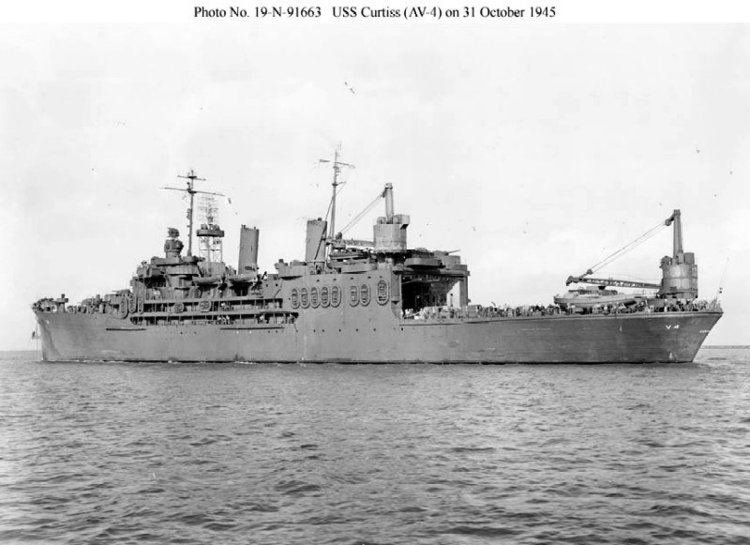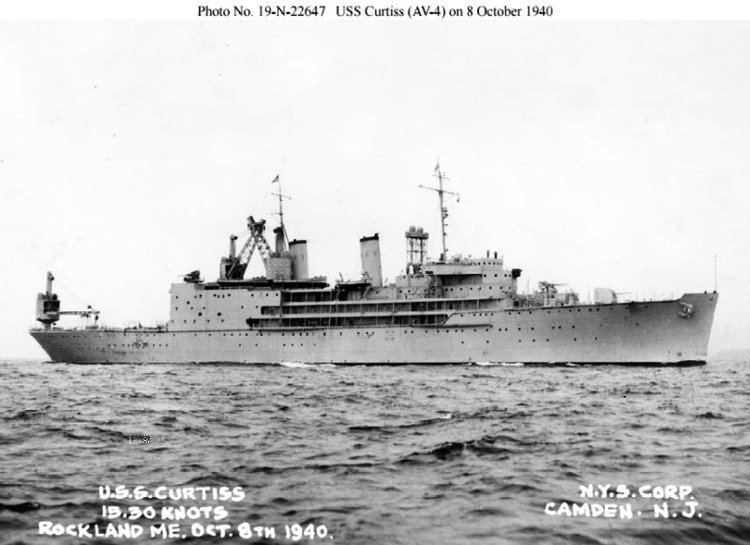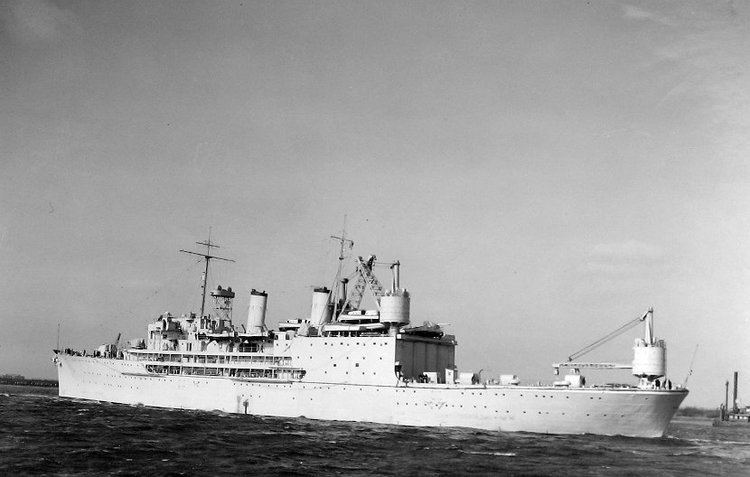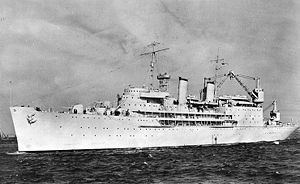Name USS Curtiss Decommissioned 24 September 1957 Launched 20 April 1940 Displacement 7.866 million kg | Commissioned 15 November 1940 Struck 1 July 1963 Length 161 m Beam 21 m | |
 | ||
Honors andawards 7 battle stars (World War II) Fate Sold for scrapping, February 1972 Builder New York Shipbuilding Corporation | ||
USS Curtiss (AV-4) was a seaplane tender of the United States Navy. The ship was launched on 20 April 1940 by the New York Shipbuilding Corporation of Camden, New Jersey, sponsored by Mrs. H. S. Wheeler, and commissioned on 15 November 1940, Commander S. P. Ginder in command.
Contents

World War II
Curtiss operated out of Norfolk and in the Caribbean for training and in fleet exercises through the spring of 1941. Curtiss was one of 14 ships to receive the early RCA CXAM-1 radar. On 26 May, she got underway for Pearl Harbor from which she served on patrol as well as tending two patrol bomber squadrons. From 15 October-9 November, she voyaged to Wake Island carrying aviators, air-crewmen, and cargo to reinforce the garrison there.

When the Japanese attacked Pearl Harbor, Curtiss got underway immediately, firing at the Japanese planes. At 08:36, she sighted a periscope and opened fire. A torpedo from the submarine narrowly missed the Curtiss, smashing into a dock at Pearl City. Four minutes later, the Japanese midget submarine surfaced and was further damaged by gunfire before diving again, after which the destroyer Monaghan took over with a ramming and depth charge attack. Curtiss turned her attention to the air again. At 09:05, she hit a Japanese plane which crashed into her No. 1 crane and burned. Three minutes later, she splashed a plane, then began firing at a dive bomber. A bomb from this plane struck Curtiss in the vicinity of her damaged crane and exploded below decks, setting the hangar and main decks and No. 4 handling room on fire, as the plane splashed off her port beam. Despite 19 dead and many wounded, Curtiss' crew quenched the fires, then turned to for emergency repairs.

On 28 December, she was underway for San Diego for permanent repairs and replacement of the damaged crane with 20 mm (0.79 in) anti-aircraft cannon. Her repairs were completed in only four days, she was back in Pearl Harbor on 13 January 1942 to begin the job of ferrying men and supplies to forward bases at Samoa, Suva, and Nouméa until June.

Departing Pearl Harbor on 2 June 1942, Curtiss served as flagship for Commander, Naval Air, South Pacific, at Nouméa from 16 June-4 August, then served as seaplane tender, flagship, repair and supply ship for destroyers and small craft engaged in the Solomons operation from Espiritu Santo until 9 July 1943. After overhaul at San Francisco, she arrived at Funafuti, Ellice Islands, 7 November to serve as flagship for Commander Air, Central Pacific, based at Funafuti until 29 December 1943, then at Tarawa (31 December 1943 – 8 March 1944), Kwajalein (10 March-26 June), Eniwetok (27 June-9 August), Saipan (12 August 1944 – 1 January 1945), and Guam (2 January-7 February).

After repairs at San Francisco, Curtiss sailed to Okinawa, arriving on 22 May 1945 to serve as flagship for Commander, Fleet Air Wing 1. On 21 June, a kamikaze and its bomb ripped two holes in her hull and exploded on the third deck, killing 35 and wounding 21 of her crew. Effective damage control kept her afloat, and four days later she was underway for the west coast and an overhaul at Mare Island Navy Yard.
Post-war
Rejoining the Fleet in the Western Pacific, Curtiss embarked Commander, Fleet Air Wing 1 (who was also Commander Task Force 75) at Okinawa on 5 December 1945. From May 1946 to June 1947 Curtiss was commanded by Captain Winfield Scott Cunningham who was in command at Wake Island during his heroic defense in December 1941. She joined in fleet exercises, operated with patrol squadrons in the Formosa Strait, ferried men and supplies to outlying bases and made several visits to Tsingtao, China until 8 March 1947, when she headed for the west coast for overhaul and alterations recommended by the Atomic Energy Commission for stowage of scientific equipment. In 1948, the Curtiss arrived at Eniwetok with atom bombs on board for the exercise "Operation Sandstone", afterward returning to the West Coast, and soon thereafter was engaged in exercises in Alaskan waters, returning to San Francisco in early 1949.
Curtiss operated off the California coast on a number of fleet and training exercises until early in 1949 when she served as flagship for Commander 1st Fleet for three weeks of amphibious operations in Alaskan waters to evaluate cold weather equipment. She continued to serve as flagship for this command during amphibious exercises off Seattle during the summer of 1949. Shortly after the outbreak of the Korean War, Curtiss sailed from San Diego to join the 7th Fleet in July 1950 on patrol in the Korea Strait. Sailing out of Iwakuni and Kure, she tended two Martin PBM Mariner squadrons and a squadron of British Short Sunderlands operating over Korean territory. She returned to San Francisco on 14 January 1951 for further alterations to fit her as a base for scientific work.
From 23 February-13 June, Curtiss served as flagship for "Operation Greenhouse" and was the base for civilian and military technicians during the atomic tests at Eniwetok. She also provided meteorological information and operated a boat pool. Curtiss served at San Diego in local operations until 29 September 1952, when she again sailed to Eniwetok as flagship during the atomic tests of "Operation Ivy", during which the first hydrogen bomb was detonated. Returning to San Diego on 4 December, she cruised the west coast, and visited Acapulco, Mexico in 1953. From 10 January-28 May 1954, she participated in "Operation Castle".
Fitted with a helicopter deck in November–December 1954, Curtiss engaged in a large scale amphibious exercise on the coast of California in March 1955. From 21 March-8 August 1956, she took part in "Operation Redwing", the atomic tests at Eniwetok, during which she was visited by the Assistant Secretary of the Navy. As flagship for the First Fleet she was visited by Vice Admiral A. H. Vdel, Commander-in-Chief of the Royal Danish Navy on 20 September 1956.
Curtiss departed San Diego on 27 December for "Operation Deep Freeze II", carrying sailors of the wintering-over party, and scientists to take part in the International Geophysical Year program. Calling at Port Lyttelton, New Zealand from 12–15 January 1957, she entered McMurdo Sound on 19 January and transferred cargo by helicopter to the icebreaker Glacier. From 21–28 January, she put men and cargo ashore in the same manner as she lay moored to the ice shelf, continuing these operations at Little America from 30 January-6 February. She carried out ice reconnaissance to Okuma Bay and Sulzberger Bay, then departed McMurdo Sound on 10 February. She called at Port Lyttelton and Auckland, New Zealand, and Sydney, Australia, before returning to San Diego on 25 March to undergo repairs for ice damage. She continued her local operations until placed out of commission in reserve on 24 September 1957.
Curtiss was struck from the Naval Vessel Register on 1 July 1963, and was sold for scrapping in February 1972.
